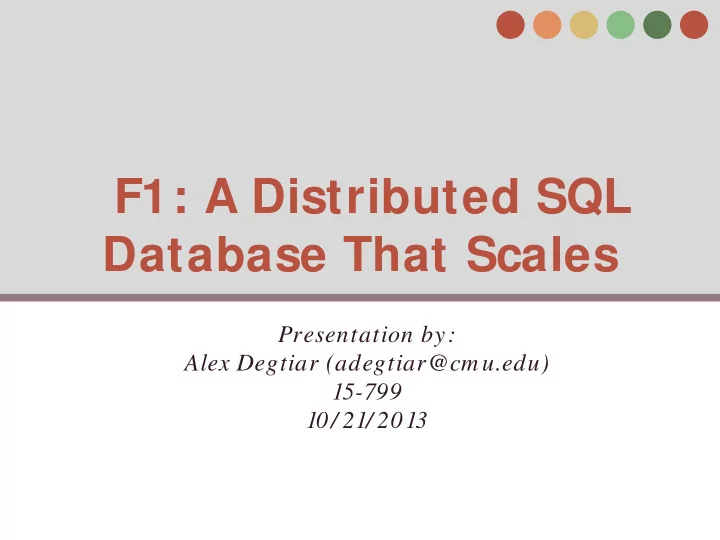

F1: A Distributed SQL Database That Scales Presentation by: Alex Degtiar (adegtiar@cm u.edu) 15-799 10/ 21/ 2013
What is F1? • Distributed relational database • Built to replace sharded MySQL back-end of AdWords system • Combines features of NoSQL and SQL • Built on top of Spanner
Goals • Scalability • Availability • Consistency • Usability
Features I nherited From Spanner ● Scalable data storage, resharding, and rebalancing ● Synchronous replication ● Strong consistency & ordering
New Features I ntroduced ● Distributed SQL queries, including joining data from external data sources ● Transactionally consistent secondary indexes ● Asynchronous schema changes including database reorganizations ● Optimistics transactions ● Automatic change history recording and publishing
Architecture
Architecture - F1 Client ● Client library ● Initiates reads/writes/transactions ● Sends requests to F1 servers
Architecture
Architecture - F1 Server ● Coordinates query execution ● Reads and writes data from remote sources ● Communicates with Spanner servers ● Can be quickly added/removed
Architecture
Architecture - F1 Slaves ● Pool of slave worker tasks ● Processes execute parts of distributed query coordinated by F1 servers ● Can also be quickly added/removed
Architecture
Architecture - F1 Master ● Maintains slave membership pool ● Monitors slave health ● Distributes list membership list to F1 servers
Architecture
Architecture - Spanner Servers ● Hold actual data ● Re-distribute data when servers added ● Support MapReduce interaction ● Communicates with CFS
Data Model ● Relational schema (similar to RDBMS) ● Tables can be organized into a hierarchy ● Child table clustered/interleaved within the rows from its parent table ○ Child has foreign key as prefix of p-key
Data Model
Secondary I ndexes ● Transactional & fully consistent ● Stored as separate tables in Spanner ● Keyed by index key + index table p-key ● Two types: Local and Global
Local Secondary I ndexes ● Contain root row p-key as prefix ● Stored in same spanner directory as root row ● Adds little additional cost to a transaction
Global Secondary I ndexes ● Does not contain root row p-key as prefix ● Not co-located with root row ○ Often sharded across many directories and servers ● Can have large update costs ● Consistently updated via 2PC
Schema Changes - Challenges ● F1 massively and widely distributed ● Each F1 server has schema in memory ● Queries & transactions must continue on all tables ● System availability must not be impacted during schema change
Schema Changes ● Applied asynchronously ● Issue: concurrent updates from different schemas ● Solution: ○ Limiting to one active schema change at a time (lease on schema) ○ Subdivide schema changes into phases ■ Each consecutively mutually compatible
Transactions • Full transactional consistency • Consists of multiple reads, optionally followed by a single write • Flexible locking granularity
Transactions - Types • Read-only: fixed snapshot timestamp • Pessimistic: Use Spanner’s lock transactions • Optimistic: Read phase (Client collects timestamps) o Pass to F1 server for commit o Short pessimistic transaction (read + write) o Abort if conflicting timestamp Write to commit if no conflicts
Optimistic Transactions: Pros and Cons Pros • Tolerates misbehaving clients • Support for longer transactions • Server-side retryability • Server failover • Speculative writes Cons • Phantom inserts • Low throughput under high contention
Change History ● Supports tracking changes by default ● Each transaction creates a change record ● Useful for: ○ Pub-sub for change notifications ○ Caching
Client Design ● MySQL-based ORM incompatible with F1 ● New simplified ORM ○ No joins or implicit traversals ○ Object loading is explicit ○ API promotes parallel/async reads ○ Reduces latency variability
Client Design ● NoSQL interface ○ Batched row retrieval ○ Often simpler than SQL ● SQL interface ○ Full-fledged ○ Small OLTP, large OLAP, etc ○ Joins to external data sources
Query Processing ● Centrally executed or distributed ● Batching/parallelism mitigates latency ● Many hash re-partitioning steps ● Stream to later operators ASAP for pipelining ● Optimized hierarchically clustered tables ● PB-valued columns: structured data types ● Spanner’s snapshot consistency model provides globally consistent results
Query Processing Example
Query Processing Example • Scan of AdClick table • Lookup join operator (SI) • Repartitioned by hash • Distributed hash join • Repartitioned by hash • Aggregated by group
Distributed Execution ● Query splits into plan parts = > DAG ● F1 server: query coordinator/root node and aggregator/sorter/filter ● Efficiently re-partitions the data ○ Can’t co-partition ○ Hash partitioning BW: network hardware ● Operate in memory as much as possible ● Hierarchical table joins efficient on child table ● Protocol buffers utilized to provide types
Evaluation - Deployment ● AdWords: 5 data centers across US ● Spanner: 5-way Paxos replication ● Read-only replicas
Evaluation - Performance ● 5-10ms reads, 50-150ms commits ● Network latency between DCs ○ Round trip from leader to two nearest replicas ○ 2PC ● 200ms average latency for interactive application - similar to previous ● Better tail latencies ● Throughput optimized for non-interactive apps (parallel/batch) ○ 500 transactions per second
I ssues and Future work ● High commit latency ● Only AdWords deployment show to work well - no general results ● Highly resource-intensive (CPU, network) ● Strong reliance on network hardware ● Architecture prevents co-partitioning processing and data
Conclusion ● More powerful alternative to NoSQL ● Keep conveniences like SI, SQL, transactions, ACID but gain scalability and availability ● Higher commit latency ● Good throughput and worst-case latencies
References • Information, figures, etc.: J. Shute, et al., F1: A Distributed SQL Database That Scales, VLDB, 2013. • High-level summary: http://highscalability.com/blog/2013/10/8/f1-and- spanner-holistically-compared.html
Recommend
More recommend